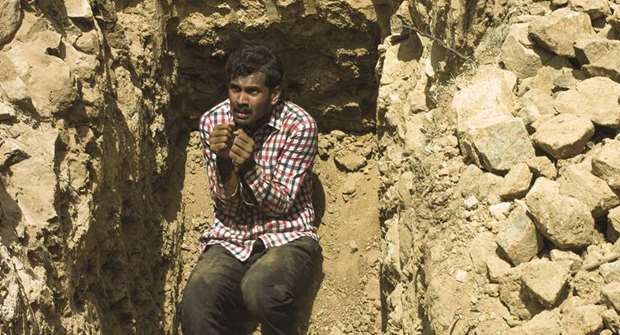Cinema of social relevance is what India would like to talk about. And screen it too. But often, the more pressing of the community dilemmas are not allowed to be discussed on the screen by the powers that be. Safety of women is a huge problem in India, and they do not feel safe even in some of India’s most policed cities and regions. This is what Sanal Sasidharan’s S Durga wanted to tell us. But it was not allowed to. And what does this work tell us? That a woman in India feels unsafe even when she has a man with her – and this is all the more so when she finds herself on lonely roads at night.
But not everybody is so unlucky as Sasidharan was. Some directors do find a way to say what they want to without being checkmated. Anurag Kashyap’s latest, Mukkabaaz, deals with cow vigilantism, and more importantly, how men of upper castes in India dominate even fields like sports. A promising boxer played by Vineet Kumar Singh is pushed down and made to cower around by a politician (Jimmy Shergill). Till, he rebels and wins.
Akshay Kumar’s Toilet: Ek Prem Katha is a searing look at the lack of proper toilets. And women who go into the fields even before dawn breaks for obvious reasons often fall prey to rapists. So, there is also the question of women’s well-being here, apart from the question of public hygiene.
However, Tamil director Amshan Kumar, who has made several social documentaries, feel that apart from lack of toilets (or the reluctance to have one inside one’s house), there is another issue which disturbs communal harmony in India. His latest fiction feature, Manusangada or Cry Humanity is a brutally frank take on how Dalits are treated in Tamil Nadu. They have been discriminated for centuries, despite laws to the contrary.
I remember my mother saying how in a Kerala village, where she grew up in the 1930s, the upper caste Hindus would not even want the shadow of a Harijan (now Dalit) to cross their paths. So terrifying was the rigidity of this social fence.
Manusangada, based on a real 2016 incident in a village not very far from Chennai (with its educated elite and cosmopolitan crowds), narrates the story of a youth, Kolappan (played by Rajeev Anand), who is woken up one morning with the news of his father’s death. He rushes from Chennai, where he is working, to his rural home to meet his grieving mother and perform the last rites.
But what shakes him more than his father’s untimely death is the social obstacle placed by caste Hindus on the road to the burial ground. Although the Dalits are free to use the main thoroughfare in their day-to-day activities, they are forbidden to take their dead along this road. Instead, they have to use a rough uneven path, strewn with thorns and wild plants, to carry their dead bodies to the burial place.
This has been a perennial problem in the village (and in many other villages), and the Government’s assurance to lay a proper road for the Dalits has not left the drawing-board.
Kolappan, young and haughty and full of modern ideas, decides that he will take his father’s body only through the main thoroughfare, and when hostility and protests raise their ugly heads, he moves the Madras High Court with a writ petition. The court understands his displeasure at such divisiveness, and orders the village administration and the police to make sure that Kolappan’s father gets a decent burial.
But he does not, with both the police and the bureaucracy conniving with the higher castes, and making sure that the funeral procession does not use the main road. Not just this, when the cops find Kolappan and his people defiantly offering resistance, the men in uniform arrest them and carry the corpse themselves – and bury it in an undisclosed grave!
A line at the end of movie tells us that Kolappan is yet to find his father’s grave.
Apart from the gravity of a prejudice that will horrify any modern thinker, I was appalled by the fact that a judicial verdict was flouted with such impunity.
(We saw something similar being played out at the recent International Film Festival of India at Goa’s Panaji, where S Durga could not be screened despite a clear court order that the movie must be shown.)
Amshan Kumar told me recently that “while such social intolerance in America is visible, since it exists between the blacks and whites, it is devious and hidden in India. For, nobody can really tell the difference between a Dalit and a high-caste or higher-caste Hindu. They all look the same. So, the hatred which exists between these two sections, Dalits and non-Dalits is camouflaged, and often the injustice perpetrated by one or the other is very well disguised”.
However, “for many years, Dalits bore all this inequity stoically. But the past five or six years have seen a greater awareness among the community, which is now rising against this kind social injustice”. Kumar added.
He also regretted that much of the mainstream media chased more “glamorous kind of problems – like, for instance, honour killing”. But it pays little attention to issues like lack of dignity for the dead among the Dalits.
But what do you do when the state executive is unwilling to help the downtrodden!
*Gautaman Bhaskaran has been
writing on Indian and world cinema
for close to four decades, and may be e-mailed at [email protected]

DISCRIMINATION: Rajeev Anand in a scene. The film is based on a real 2016 incident in a village not very far from Chennai.

